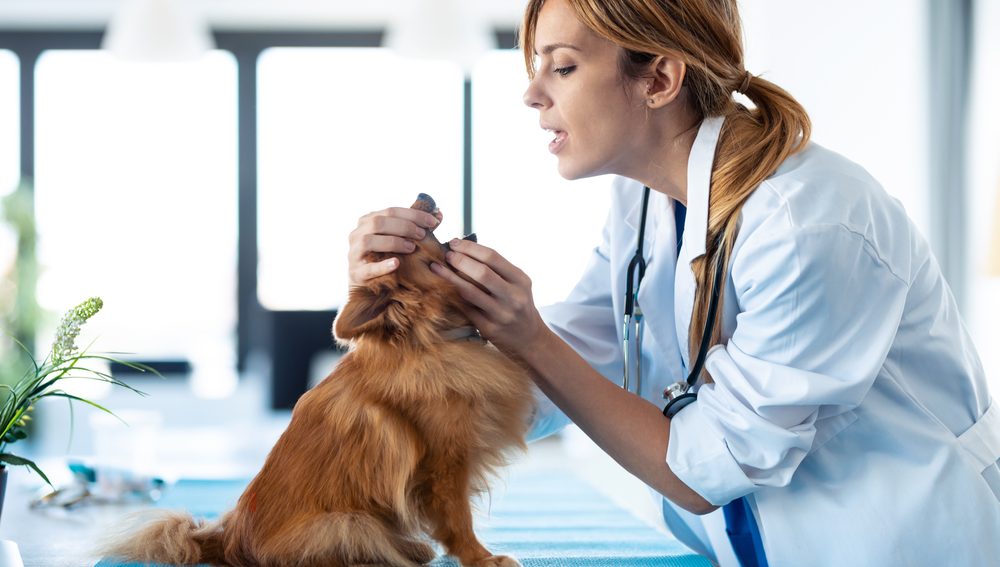
5 Reasons Your Pet Needs Regular Professional Veterinary Dental Cleanings
A healthy mouth is an important part of your pet’s long-term health and comfort. Often pet owners overlook their pet’s dental care, but poor dental hygiene can have significant consequences. February is National Pet Dental Health Month, and our Harbor Pines Veterinary Center team wants to heighten awareness about this important issue by explaining why your pet needs regular professional veterinary dental cleanings.
#1: Dental disease is common in pets
Dental issues are extremely common in pets, with an estimated 80% of dogs and 70% of cats older than age 3 years having some degree of periodontal disease. In addition, tooth resorption lesions occur in about 50% of cats older than 5 years of age, and occasionally in dogs.
#2: Pets are stoic creatures
Dental disease can lead to significant discomfort and pain, but pets tend to hide vulnerabilities. In the wild, an animal who is exhibiting pain can be targeted as a predator’s next meal. While you likely don’t have wild animals roaming around your home, your pet maintains the instinct to appear strong, so they usually show no signs of a health problem, such as dental disease, until the condition is advanced. Signs that may be present include:
- Bad breath — Bacteria that accumulate in your pet’s mouth produce sulfur compounds that smell bad, and bad breath is the most common sign of dental disease.
- Discolored teeth — Plaque and tartar accumulation can cause yellow or brown discoloration of your pet’s teeth.
- Behavioral changes — A pet affected by oral pain may withdraw, or be uncharacteristically irritable or aggressive.
- Nasal or ocular discharge — In some cases, dental disease can affect the nasal passages or eyes, and chronic nasal or ocular discharge may occur.
#3: Dental disease can cause significant health problems for pets
While bad breath is the most common issue that pet owners notice in their pet with dental disease, the condition can cause many, much more serious health problems, such as:
- Bleeding gums — The first stage of periodontal disease is gingivitis. At this stage, bacteria irritate and inflame the gingiva, leading to swelling and bleeding that can be extremely uncomfortable for your pet.
- Loose teeth — As periodontal disease progresses, the bacteria damage the tooth’s supporting structures, and eventually the tooth loses stability, which can make chewing difficult. When the tooth is lost or extracted, the space that results can collect food, leading to additional problems.
- Tooth root abscesses — If bacteria enter the tooth root, an abscess can form which, if not treated promptly, can create a draining tract in your pet’s face or jaw.
- Oronasal fistula — Periodontal disease affecting an upper tooth can migrate through the soft palate, creating an opening into the nasal cavity that allows food, water, and saliva to enter the nasal passage, leading to inflammation.
- Eye infections — Your pet’s eyes sit close to their back upper tooth roots, and periodontal disease can lead to eye infections.
- Jaw fractures — In advanced stages, periodontal disease invades bony tissue, weakens the bone, and potentially leads to a fracture. Small pets, such as cats and toy-breed dogs, are at highest risk for jaw fractures associated with periodontal disease.
- Oral cancer — Periodontal disease causes chronic inflammation inside the mouth and has been linked to increased risk for oral cancer in humans.
- Heart disease — Bacteria typically isolated from pets affected by endocarditis and valvular disease are the same pathogens found in those with dental disease. Studies have linked periodontal disease to an increased heart disease risk in pets.
- Liver and kidney disease — The liver and kidneys are responsible for filtering the blood, and when periodontal bacteria enter the bloodstream, these organs are vulnerable to damage.
#4: Dental disease lurks below your pet’s gum line
Bacteria below your pet’s gum line cause the most damage, and to effectively clean this area, ensure your pet does not experience stress during the procedure, and prevent injury from the sharp instruments we use to evaluate and clean their teeth, your pet must be anesthetized. A veterinary professional monitors your pet’s vitals during the entire procedure until they fully recover, and changes their anesthetic level as needed. Since anesthesia is necessary, we perform diagnostics, such as a thorough physical exam, complete blood count, and biochemistry profile, to ensure they are healthy enough to undergo the procedure. If abnormalities are detected, we may recommend other diagnostics, such as chest X-rays or a heart ultrasound.
#5: Dental X-rays are necessary to fully evaluate a pet’s oral health
About 50% to 60% of the tooth and supporting structures are below the gum line, which means dental X-rays are necessary to view this anatomy, or we will not be able to devise an appropriate treatment strategy for your pet. Lesions that can be seen only on dental X-rays include:
- Devitalized tooth roots
- Tooth resorption lesions
- Tooth root infections
- Jaw fractures
- Bone loss
Most pets should receive a professional veterinary dental cleaning about once a year, but pets at high risk for dental disease, including senior pets, toy-breed dogs, and brachycephalic pets, should be evaluated more frequently. If you are concerned about your pet’s dental health, contact our Harbor Pines Veterinary Center team, so we can evaluate their mouth and advise you on the best options for maintaining their oral health.

